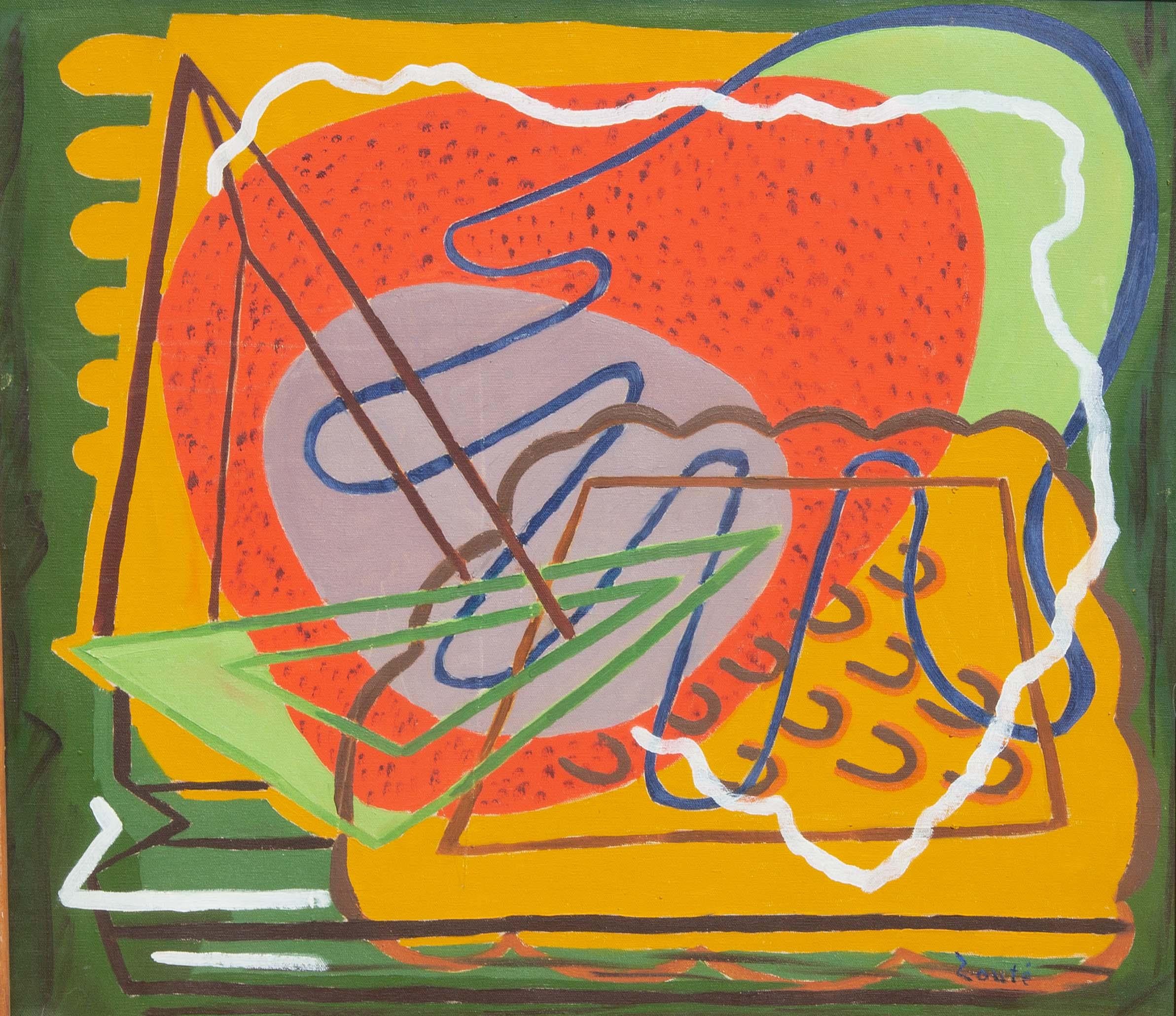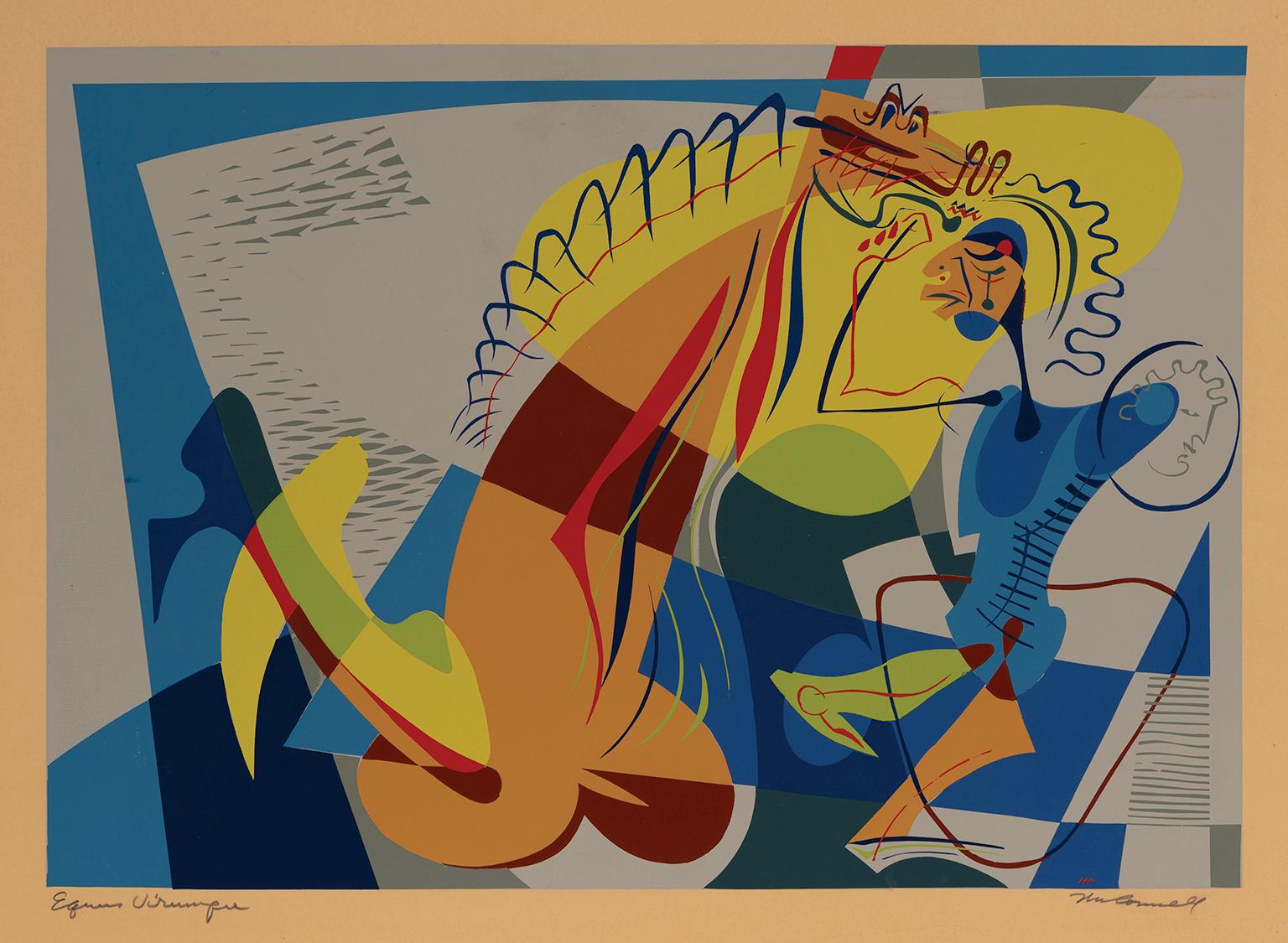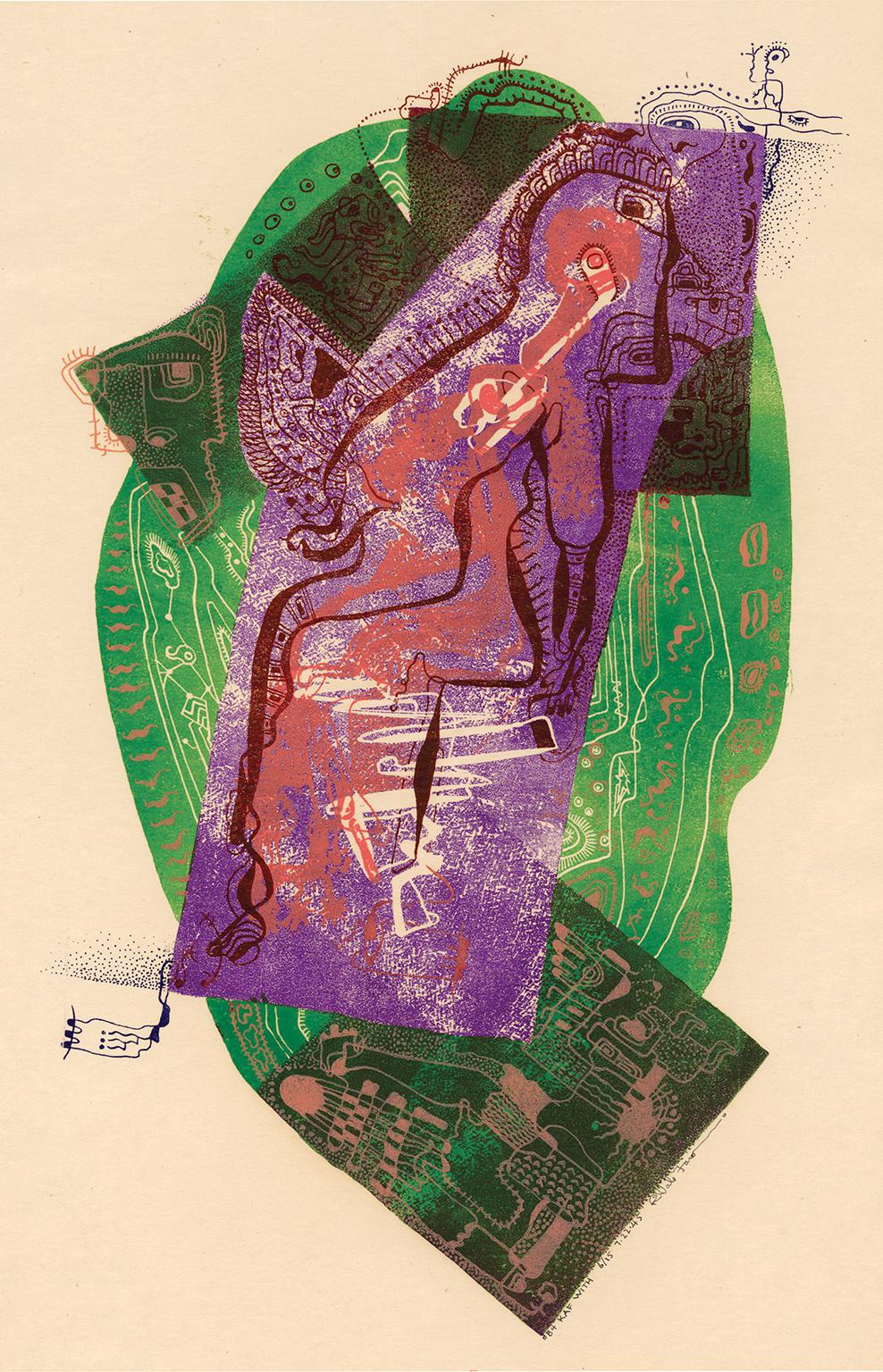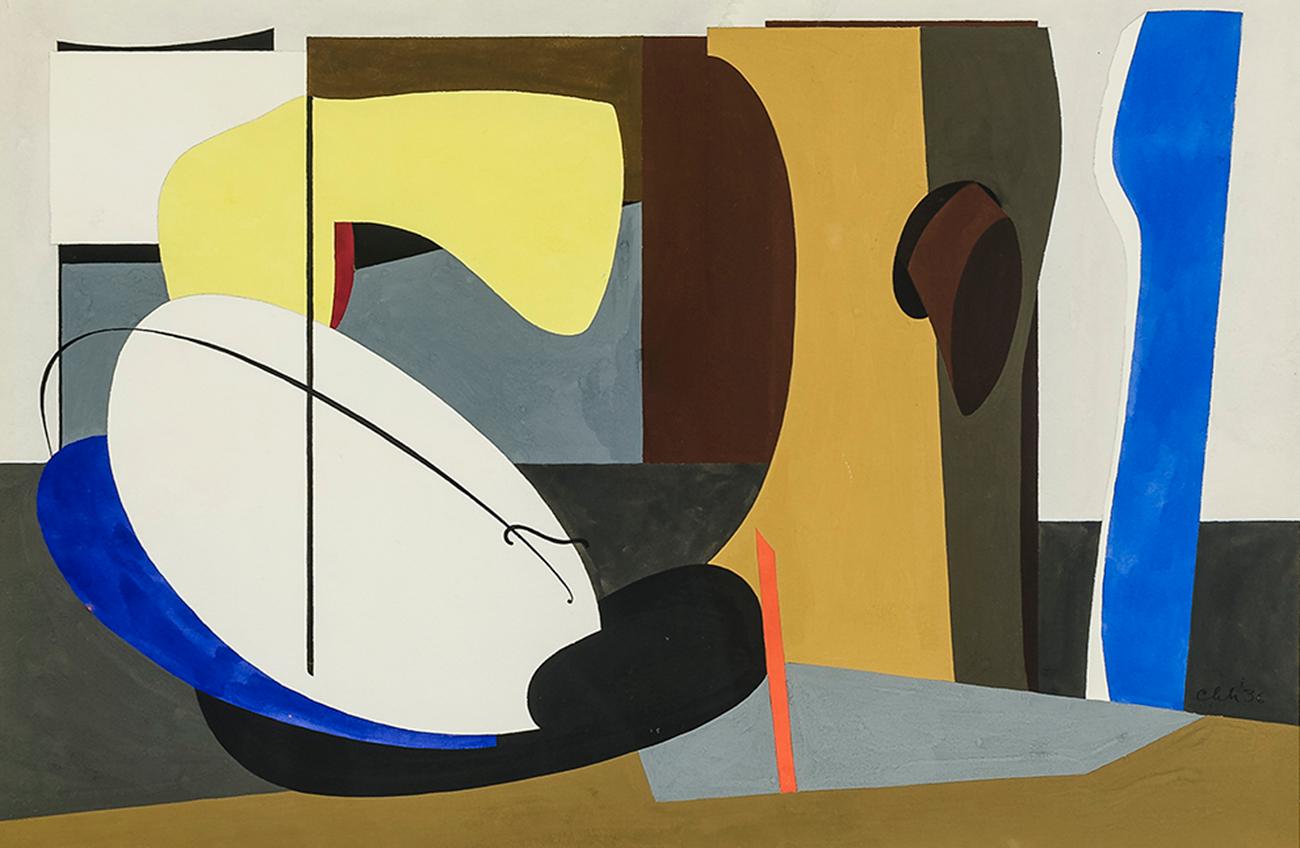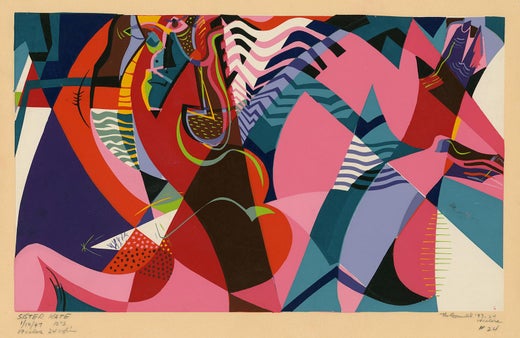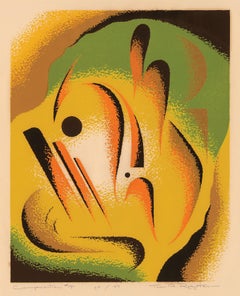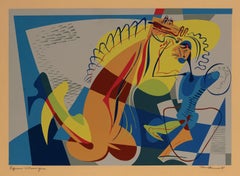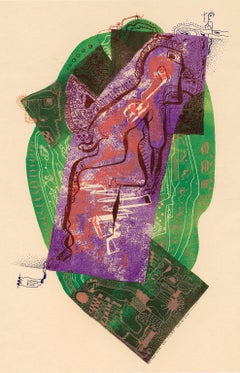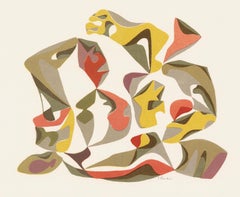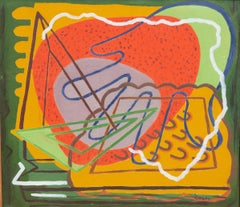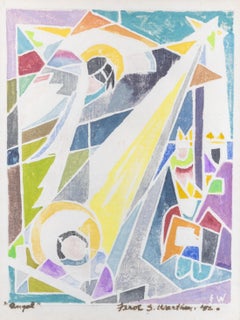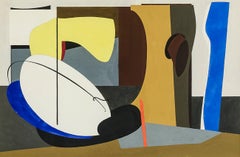Items Similar to Sister Kate — Mid-century, Jazz-inspired Modernism
Want more images or videos?
Request additional images or videos from the seller
1 of 3
James Houston McConnellSister Kate — Mid-century, Jazz-inspired Modernism1947
1947
$1,800
£1,364.86
€1,565.96
CA$2,561.18
A$2,778.30
CHF 1,460.99
MX$33,806.31
NOK 18,264.68
SEK 17,225.83
DKK 11,691.91
About the Item
James Houston McConnell, 'Sister Kate', color serigraph, 1947, edition 24. Signed, dated, titled, and numbered '24' in pencil. Annotated '10.00 - 19 colors - 24 copies - #24' in pencil. A fine impression, with vibrant, fresh colors, on heavy tan wove paper, with full margins (11/16 to 1 1/2 inches). Tack holes in the four margin corners, well away from the image, otherwise in excellent condition. Matted to museum standards, unframed. Scarce.
Another of McConnell's mid-century modernist, jazz-inspired serigraphs, 'Combo', is featured in the British Museum's 2008 publication (and traveling exhibition) 'The American Scene: Prints from Hopper to Pollock'.
ABOUT THE IMAGE
"I Wish I Could Shimmy Like My Sister Kate", often simply "Sister Kate", is an up-tempo jazz dance song, written by Armand J. Piron and published in 1922. The lyrics of the song are narrated in the first person by Kate's sister, who sings about Kate's impressive dancing skill and her wish to be able to emulate it. She laments that she's not quite "up to date", but believes that dancing like "Sister Kate" will rectify this, and she will be able to impress "all the boys in the neighborhood" like her sister.
Over the years this song has been performed and recorded by many artists, including Frances Faye and Rusty Warren, a 1959 version by Shel Silverstein, The Olympics in 1960 (released as "Shimmy Like Kate"), the Red Onion Band, and a beat version by The Remo Four in 1964. It was performed live by The Beatles in 1962, and a recording of one such performance appears on 'Live! At the Star-Club in Hamburg, Germany; 1962'. The song arrived in the 1960s and 1970s folk scene thanks to Dave Van Ronk (recording it twice on In the Tradition and on Dave Van Ronk and the Ragtime Jug Stompers) and Jim Kweskin, who made it part of a "Sister Kate's Night Out" medley on his Relax Your Mind album[3] with Mel Lyman and Fritz Richmond. In 1967, the Nitty Gritty Dirt Band included it in their eponymous The Nitty Gritty Dirt Band (album).
David Bowie used to team this song with an updated version of the Flares 1960 doo-wop song "Foot Stompin'" during the (1974) Diamond Dogs tour, as heard on the compilation Rarest One Bowie. Guitarist Carlos Alomar blessed the update with a riff that became Bowie's hit "Fame", co-written with John Lennon. Judith Durham recorded a version for her album, Judith Durham and The Hottest Band in Town (1974).
ABOUT THE ARTIST
Painter and printmaker James Houston McConnell (1914-200) was born in Chicago. He studied at Denison University, the State University of Iowa, and with Grant Wood, Jean Charlot, Fletcher Martin, and Emil Ganso. He taught at Michigan State College and was a member of both the National Serigraphy Society and the American Color Print Society.
McConnell’s work was shown in numerous mid-century museum exhibitions including the Whitney Museum of American Art, 1941; Kansas City Art Institute, 1941-42; American Color Print Society, 1942 (prize); Northwest Print Museum, 1942-46; City Art Museum of St. Louis, 1942 (prize); Springfield (Mo.) Museum of Art, 1942 (prize); Zanesville, Ohio, 1945 (prize); Union Seaman’s Service Traveling Exhibition, 1943-33; National Academy of Design, 1946; United States Library of Congress, 1946; and Laguna Beach Art Association, 1946.
McConnell’s work is held in the permanent collections of the Brooklyn Museum, The British Museum, Denison University, State University of Iowa, and the City Art Museum of St. Louis.
- Creator:James Houston McConnell (1914 - 1988)
- Creation Year:1947
- Dimensions:Height: 8.63 in (21.93 cm)Width: 14.07 in (35.74 cm)
- Medium:
- Movement & Style:
- Period:
- Condition:
- Gallery Location:Myrtle Beach, SC
- Reference Number:Seller: 1001491stDibs: LU53234490801
James Houston McConnell
Born in Chicago, Illinois, James Houston McConnell was a lithographer, screenprinter and painter. He studied at Denison University, the University of Iowa, and with Grant Wood, Jean Charlot, Fletcher Martin and Emil Ganso. He taught at Michigan State College and was a member of both the National Serigraph Society and the American Color Print Society. Another of McConnell's mid-century modernist, jazz-inspired serigraphs, Combo, is featured in the British Museum's 2008 publication (and traveling exhibition) The American Scene: Prints from Hopper to Pollock.
About the Seller
5.0
Recognized Seller
These prestigious sellers are industry leaders and represent the highest echelon for item quality and design.
Platinum Seller
Premium sellers with a 4.7+ rating and 24-hour response times
Established in 1995
1stDibs seller since 2016
322 sales on 1stDibs
Typical response time: 1 hour
Associations
International Fine Print Dealers Association
- ShippingRetrieving quote...Shipping from: Myrtle Beach, SC
- Return Policy
Authenticity Guarantee
In the unlikely event there’s an issue with an item’s authenticity, contact us within 1 year for a full refund. DetailsMoney-Back Guarantee
If your item is not as described, is damaged in transit, or does not arrive, contact us within 7 days for a full refund. Details24-Hour Cancellation
You have a 24-hour grace period in which to reconsider your purchase, with no questions asked.Vetted Professional Sellers
Our world-class sellers must adhere to strict standards for service and quality, maintaining the integrity of our listings.Price-Match Guarantee
If you find that a seller listed the same item for a lower price elsewhere, we’ll match it.Trusted Global Delivery
Our best-in-class carrier network provides specialized shipping options worldwide, including custom delivery.More From This Seller
View All'Composition # 4' — Mid-Century Modernism
By Thomas A. Robertson
Located in Myrtle Beach, SC
Thomas Robertson, 'Composition #4,' color serigraph, edition 47, c. 1940. Signed, titled, and annotated 'Ed/47' in pencil. A superb, painterly impression, with fresh colors, on buff wove paper, the full sheet with margins (1 to 2 inches), in excellent condition. Matted to museum standards, unframed.
Image size: 10 9/16 x 8 1/2 inches (268 x 216 mm); sheet size 13 x 12 1/2 inches (330 x 318 mm).
An impression of this work is represented in the collection of the National Gallery of Art.
ABOUT THE ARTIST
Born in Little Rock, Arkansas, Thomas Arthur Robertson (1911-1976) was the son of an attorney. Although his father, a co-owner of the Arkansas Law School, insisted that his son study there, after graduating, Robertson enrolled at the Adrian Brewer...
Category
1940s Abstract Abstract Prints
Materials
Screen
'Equus Uirumpu' — Mid-century American Modernism
By James Houston McConnell
Located in Myrtle Beach, SC
James Houston McConnell, 'Equus Uirumpu' (The Man's Horse), color serigraph, c. 1945, edition not stated but small. Signed and titled in pencil. Initialed in the image, lower right. ...
Category
1940s American Modern Abstract Prints
Materials
Screen
'Kaf With' — Mid-century American Surrealism
By Robert Vale Faro
Located in Myrtle Beach, SC
Robert Vale Faro, 'Kaf With', color lithograph, 1945, edition 15. Signed, dated, titled and numbered '84' and '6/15' in pen, recto. Titled, numbered '#84' and '6/15' and dated '7/22/...
Category
1940s American Modern Abstract Prints
Materials
Lithograph
'Salient in February' — Mid-Century Abstraction
By Edward August Landon
Located in Myrtle Beach, SC
Edward Landon, 'Salient in February', color serigraph, 1945, edition 25, Ryan 166. Signed in pencil. Titled, dated, and annotated 'ED. 40' in pencil. A fine impression, with fresh colors, on cream, wove paper; with full margins (1 3/4 to 2 5/8 inches, top sheet edge deckle); in excellent condition. Image size 9 x 11 inches; sheet size 12 3/4 x 16 inches. Matted to museum standards, unframed.
ABOUT THE ARTIST
Born in Hartford, Connecticut, Edward Landon dropped out of high school to study art at the Hartford Art School. In 1930 and 1931, he was a student of Jean Charlot at the Art Students League in New York, after which he traveled to Mexico to study privately for a year with Carlos Merida. In 1933 he settled near Springfield, Massachusetts, painted murals in the local trade school, and exhibited with the Springfield Art League. His painting 'Memorial Day' won first prize at the fifteenth annual exhibition of the League at the Springfield Museum of Fine Arts. Landon became an active member of the Artists Union of Western Massachusetts, serving as president from 1934-1938.
Landon acquired Anthony Velonis’s instructional pamphlet on the technique of serigraphy in the late 1930s. With colleagues Phillip Hicken, Donald Reichert, and Pauline Stiriss, he began experimenting with screen printing techniques. The artists' groundbreaking work in screen printing as a fine art medium was the subject of the group’s landmark exhibition at the Springfield Museum of Fine Arts in 1940.
Landon became one of the founding members of the National Serigraph Society and served as editor of its publication, 'Serigraph Quarterly,' in the late 1940s and as its president in 1952 and 1953. The Norlyst Gallery in Manhattan held a one-person show of his prints in 1945. Awarded a Fulbright Fellowship in 1950, Landon traveled to Norway, where he researched the history of local artistic traditions and produced the book 'Scandinavian Design: Picture and Rune Stones...
Category
Mid-20th Century American Modern Abstract Prints
Materials
Screen
'Bird Abstraction' — Mid-Century Modernism
Located in Myrtle Beach, SC
Stephen Harty, Untitled (Bird Abstraction), gouache, 1953. Signed and dated lower left. A fine, meticulously rendered, mid-century, modernist gouache painting, with fresh colors on 1...
Category
1950s American Modern Abstract Paintings
Materials
Gouache
'Chinoiserie' — Mid-Century Modernism
By Edward August Landon
Located in Myrtle Beach, SC
Edward Landon 'Chinoiserie', color serigraph, 1947, edition 50, Ryan 36. Signed in pencil in the image, lower right. Titled, dated, and annotated '4 COLORS – EDITION 50' in the scree...
Category
Mid-20th Century American Modern Abstract Prints
Materials
Screen
You May Also Like
Abstract Composition by Zoute (Leon Salter) Mid Century
Located in Rochester, NY
Abstract Modernist oil painting by Zoute. Oil on canvas mounted on board. Painted in circa 1940's.
Zoute (Born-Leon Salter, 1903-1976) was self-taught and well exhibited during his l...
Category
Mid-20th Century Abstract Abstract Paintings
Materials
Canvas, Oil
Angel
Located in Missouri, MO
Angel, 1952
Ferol K. Sibley Warthen (American, 1890-1986)
Color Woodblock Print
6.5 x 5 inches
16 x 13.75 inches with frame
Signed Lower Right
Titled Lower Left
Born 1890, Died 1986...
Category
1950s American Modern Abstract Prints
Materials
Color
Untitled
By Charles Houghton Howard
Located in New York, NY
Charles Houghton Howard was born in Montclair, New Jersey, the third of five children in a cultured and educated family with roots going back to the Massachusetts Bay colony. His father, John Galen Howard, was an architect who had trained at M.I.T. and the École des Beaux-Arts in Paris and apprenticed in Boston with Henry Hobson Richardson. In New York, the elder Howard worked for McKim, Mead and White before establishing a successful private practice. Mary Robertson Bradbury Howard, Charles’s mother, had studied art before her marriage. John Galen Howard moved his household to California in 1902 to assume the position of supervising architect of the new University of California campus at Berkeley and to serve as Professor of Architecture and the first Dean of the School of Architecture (established in 1903). The four Howard boys grew up to be artists and all married artists, leaving a combined family legacy of art making in the San Francisco Bay area that endures to this day, most notably in design, murals, and reliefs at the Coit Tower and in buildings on the Berkeley campus.
Charles Howard graduated from the University of California at Berkeley in 1921 as a journalism major and pursued graduate studies in English at Harvard and Columbia Universities before embarking on a two-year trip to Europe. Howard went to Europe as a would-be writer. But a near-religious experience, seeing a picture by Giorgione in a remote town outside of Venice, proved a life-altering epiphany. In his own words, “I cut the tour at once and hurried immediately back to Paris, to begin painting. I have been painting whenever I could ever since” (Charles Howard, “What Concerns Me,” Magazine of Art 39 [February 1946], p. 63). Giorgione’s achievement, in utilizing a structured and rational visual language of art to convey high emotion on canvas, instantly convinced Howard that painting, and not literature, offered the best vehicle to express what he wanted to say. Howard returned to the United States in 1925, confirmed in his intent to become an artist.
Howard settled in New York and supported himself as a painter in the decorating workshop of Louis Bouché and Rudolph Guertler, where he specialized in mural painting. Devoting spare time to his own work, he lived in Greenwich Village and immersed himself in the downtown avant-garde cultural milieu. The late 1920s and early 1930s were the years of Howard’s art apprenticeship. He never pursued formal art instruction, but his keen eye, depth of feeling, and intense commitment to the process of art making, allowed him to assimilate elements of painting intuitively from the wide variety of art that interested him. He found inspiration in the modernist movements of the day, both for their adherence to abstract formal qualities and for the cosmopolitan, international nature of the movements themselves. Influenced deeply by Surrealism, Howard was part of a group of American and European Surrealists clustered around Julien Levy. Levy opened his eponymously-named gallery in 1931, and rose to fame in January 1932, when he organized and hosted Surrealisme, the first ever exhibition of Surrealism in America, which included one work by Howard. Levy remained the preeminent force in advocating for Surrealism in America until he closed his gallery in 1949. Howard’s association with Levy in the early 1930s confirms the artist’s place among the avant-garde community in New York at that time.
In 1933, Howard left New York for London. It is likely that among the factors that led to the move were Howard’s desire to be a part of an international art community, as well as his marriage to English artist, Madge Knight...
Category
20th Century American Modern Abstract Drawings and Watercolors
Materials
Paper, Gouache, Graphite
The New Cable British Modern Mid 20th Century Vorticist European Vorticism Woman
By Sybil Andrews
Located in New York, NY
The New Cable British Modern Mid 20th Century Vorticist European Vorticism Woman
Sybil Andrews CPE (British/Canadian, 1898-1992)
"The New Cable," 1931
12 x 16 1/2 inches
Color linocut
Signed, titled, inscribed 'Second State', and numbered 13/60 in pencil
Framed: 19 x 24 inches
Literature: Coppel Sa17
Illustrated on page 10 of the catalog
The proposed edition of the first state of the Giant Cable was 50, but only 30 impressions were pulled. Andrews removed the blue background for the second state, which was published under the title The New Cable in an edition of 60.
BIO
Sybil Andrews was a printmaker, painter, graphic artist and educator who was born in Bury St. Edmonds, Suffolk, England. She moved to London (England) in 1922. In 1947, she emigrated to Campbell River (Vancouver Island) British Columbia, Canada, where she worked, taught and lived for the rest of her life. She died at a hospital in Victoria (B.C.)
Her mediums were the colour linocut (1) (most famous), etching, posters, pastels, ink, watercolour, monoprint and oil. Her subjects were human activity (at work, sports, travel, etc.), figures, animals, genre, allegory, architecture and landscape. Her style was Art Deco (see AskART styles), Futurism, Cubism and Vorticism (2). Her work is identified by a simple format, clean lines, distortion, vivid colours, drama and rhythm.
Quote: "The colour linocut was just the medium for me, being interested in dynamics and ideas and patterns... It is impossible to be fussy with lines, you have to simplify, you are forced to simplify your idea to its fundamentals." Andrews produced 76 linocuts in her life, of which 43 were made from 1929 to 1939, which is considered to be her best period.
John Hassall's art correspondence course (1918) was the beginning of her formal art education. She went from there to Heatherley's School of Fine Art (London/1922) where she studied under Henry Massey (see AskART) and met artistic partner Cyril Power (see AskART). At the same time, she studied independently with sculptor Henri Glicenstein (see AskART) who taught her drypoint etching and to draw from life.
She also attended the Grosvenor School of Modern Art (1925). Iain McNab (1890-1967) was Principal and Claude Flight (3) (see AskART) an instructor who had a great influence on her choice of linocut as a primary medium. Some of his other students and her associates were Edith Lawrence (1890-1973), Lill Tschudi (1911-2001), Eileen Mayo (see AskART) and William Greengrass (1896-1970). After emigrating to Canada she taught art continuously until a month before her death.
She was elected a member of the Canadian Painters - Etchers Society (after 1976 the Print and Drawing Council of Canada) in 1951.
She began exhibiting her work in 1921.In 1929 she was included in "The First Exhibition of British Linocuts...
Category
1930s Modern Figurative Prints
Materials
Linocut
American 1960's psychedelic design by the fashion designer Ken Scott
Located in Petworth, West Sussex
Ken Scott (American, 1918 – 1991)
Fantasia
Gouache on paper
Signed ‘Ken Scott’ (on the reverse)
15 x 10.3/4 in. (38 x 28 cm.)
Ken Scott was a fashion designer known for his fabric d...
Category
Mid-20th Century Abstract Paintings
Materials
Paper, Gouache
Antique American School Modernist Abstract Cubist Framed Mid Century Painting
Located in Buffalo, NY
Nicely painted mid century abstract cubist oil painting. Great color and composition. Framed.
Category
1950s Cubist Abstract Paintings
Materials
Canvas, Oil
$1,020 Sale Price
20% Off

